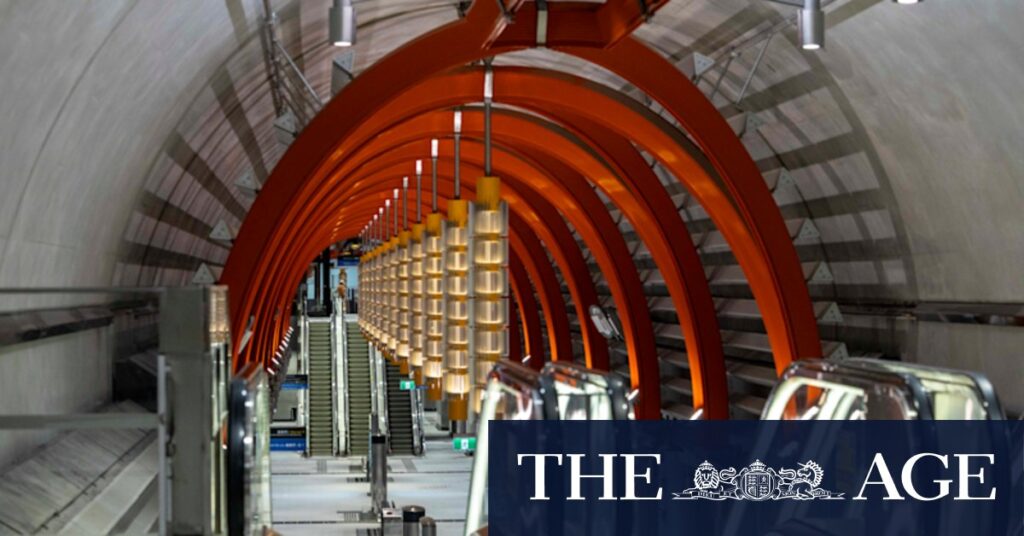
You hear it before you see it. And you feel it before you hear it. The dull tremor of mass moving at speed, the whumpfh of air pushed through a confined space, the whine of electric motors. Finally, the glow of headlights pierces the gloom. This is the scene at Melbourne’s newly completed Town Hall Station, the first new train station in the city’s Central Business District in over 40 years, located 27 meters below Swanston Street.
Though not yet open to commuters, the station is bustling with activity as ghost trains run during a testing phase for the five new Metro Tunnel stations. These trains, operating at a striking frequency, offer a glimpse into the future of Melbourne’s public transport. “This is literal turn up and go,” says Kate Walshe, director of communication for builders CYP Design and Construction, during a media tour. “Throw away the timetable.”
Revolutionary Design and Technology
The station’s designers are confident in the efficiency of the new service, so much so that they have included minimal platform seating, believing commuters won’t need it. Town Hall is part of the Metro Tunnel project, which includes five new stations and twin tunnels beneath the city, connecting Melbourne’s growth corridors at a cost of $13.4 billion, exceeding the initial $10.9 billion budget.
The architecture of Town Hall Station is intended to mirror the historic Town Hall, though its Second Empire-style porticoes and columns are hard to discern. The entrance features five long escalators descending into a concrete box, playfully dubbed “the crypt” by architects. This space, open to the public, is designed for more than just transit; it includes areas for retail and public events.
Innovative Features
On the platforms, three side-by-side cylinders have been carved out of the bedrock, creating expansive open platforms. At 18 meters wide, they rank among the world’s widest metro platforms, designed to accommodate future 10-carriage trains. The station’s design, with vaulted ceilings and pendant lights, evokes a cathedral-like atmosphere.
Two key technologies are central to the station’s operation. The first is high-capacity signalling, which wirelessly links trains, allowing them to adjust speed and maintain distance automatically, akin to radar cruise control in cars. This technology enables trains to run closer together, facilitating the rapid service observed during testing.
The second innovation is the platform screen doors, which enclose the platform when shut and open in sync with train doors. These doors enhance safety by preventing objects from falling onto the tracks and contribute to thermal stability, eliminating the need for heating or cooling systems.
Design and Aesthetics
Navigation within the station is intuitive, with “shark fins” jutting from the roof to guide passengers. One side is pink, indicating the direction towards the exit, while the other is grey, leading to the platform. The color palette, inspired by Melbourne’s sunrises and sunsets, features hues of white, pink, yellow, and orange. “The sunrise and sunset is timeless,” Walshe remarks.
While each station entrance is unique, the platforms themselves lack distinct personality, appearing nearly identical across stations. Passengers will need to remain attentive to avoid disembarking at the wrong stop, unlike the elaborately themed Moscow Metro.
Historical Context and Future Implications
The completion of Town Hall Station marks a significant milestone in Melbourne’s transportation history, reminiscent of the City Loop’s opening in the 1980s. This development is expected to alleviate congestion and improve connectivity across the city, reflecting a broader trend of urban rail expansions seen globally.
As the tour concludes at Campbell Arcade, a 1950s-era underground shopping strip now connecting Town Hall and Flinders Street stations, the integration of heritage elements with modern design is evident. The addition of granite columns and small tiles lends the new section a sense of age, a nod to Melbourne’s architectural heritage.
As Melbourne’s train system braces for transformative changes, some aspects remain constant. Exiting Flinders Street Station, a young woman struggles with her myki card, a reminder that while infrastructure evolves, everyday challenges persist. “I don’t know what happened, I literally topped this up yesterday,” she exclaims, reflecting a sentiment familiar to many commuters.
Melbourne’s new train station heralds a new era of public transport, poised to reshape the city’s commuting landscape while preserving its unique character.







